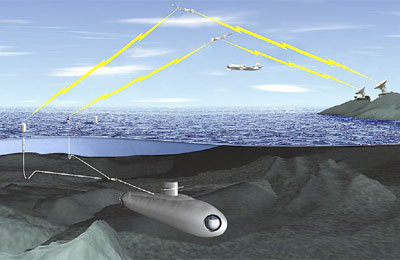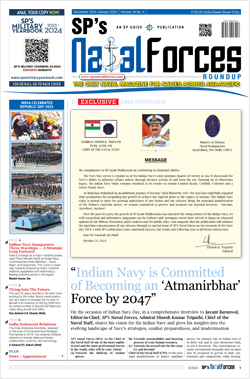INDIAN ARMED FORCES CHIEFS ON OUR RELENTLESS AND FOCUSED PUBLISHING EFFORTS

The insightful articles, inspiring narrations and analytical perspectives presented by the Editorial Team, establish an alluring connect with the reader. My compliments and best wishes to SP Guide Publications.

"Over the past 60 years, the growth of SP Guide Publications has mirrored the rising stature of Indian Navy. Its well-researched and informative magazines on Defence and Aerospace sector have served to shape an educated opinion of our military personnel, policy makers and the public alike. I wish SP's Publication team continued success, fair winds and following seas in all future endeavour!"

Since, its inception in 1964, SP Guide Publications has consistently demonstrated commitment to high-quality journalism in the aerospace and defence sectors, earning a well-deserved reputation as Asia's largest media house in this domain. I wish SP Guide Publications continued success in its pursuit of excellence.
- MoD initiates comprehensive review of Defence Acquisition Procedure 2020, pushes for defence reforms
- G7: The Swansong
- Kalinga Connect: South Asia to Polynesia
- Advanced MRSAM for India for a greater firepower
- Must Credit DRDO for Operation Sindoor, now what is next for defence R&D?
- Operation Sindoor | Day 2 DGMOs Briefing
- Operation Sindoor: Resolute yet Restrained
Submarines
Communications & NCO

To seamlessly integrate submarines into Network Centric Operations, in addition to the technological challenges which require to be overcome, there is also a need to change the way submarines do ‘business at sea’
“Using primarily space-based systems, we will create what I like to call a Battlefield Internet. Our ships, planes, subs and marines will essentially log on to this Internet and be able to achieve incredibly deep situational aware-ness because of the information power con-tained on this Internet grid. Additionally, naval or joint force commanders will have increased visibility across the spectrum of assets avail-able to them, giving them incredible flexibility to match targets to weapons and delivery platforms. We call this new way of thinking and fighting ‘Network Centric Warfare’, and it’s a term you’ll hear a lot in the future.”
—Admiral Jay L. Johnson, Former Chief of Naval Operations, US Navy
Any navy intending to influence events ashore, must aim for full integration of submarines, espe-cially the SSNs, into its expedi-tionary task forces. To be effective units of a Naval Task Group, within a Joint Force, submarines must be capable of tailoring on-board capabilities to optimise their support for the Joint Task Force and Naval Component Commanders. One of the capabilities critical for this integration is the ability of the subma-rine to mesh into net-centric infrastructure and become an active and capable player in Net Centric Operations (NCO).
For the submarine force, however, NCO is a double edged sword. While there exists the potential for submarines to derive significant benefits from the net centric infrastructure and also from other new levels of mutual support, accepting a net centric role for submarines imposes new requirements and demands. Certain ‘sacrifices’ from subma-rines to break away from their traditional inde-pendent ocean operations is essential. This article attempts to analyse all aspects of the NCO impact on submarines.
Emerging roles for submarines
In the current global scenario, there is a renewed emphasis on using sea power to influence events on land. While submarines will continue to be called upon to undertake their legacy roles, there will be an enhancement in the role submarines will now be called upon to perform as follows:
• Intelligence, Surveillance and Reconnaissance (ISR)
• Sea Control
• Land Attack
• Anti-Submarine Warfare
Technology challenges
For a submarine force to be a capable player in NCO, it needs to be a full participant in the underlying information network. This will not only enhance the common operations picture for inter-operability and force coordination, but also augment internal information handling capability, ensuring the submarine commander can make better informed decisions, execute cooperation engagement and reduce tactical response time. In addition, the network will also be used for real time transfer of intel-ligence, weather update and critical logistic information.
For submarines, the prerequisite for admission to NCO is the availability of new communication infrastructure to support trans-fer and handling of data, many times more than is possible even in the most modern navies today. This infrastructure would include antennas, trans-receivers, internal switching, system control and data distribution, and so on. All these capabilities would enhance submarine communication and bring them at par with those of large surface combatants. However, it is imperative that submarines acquire these new capabilities without com-promising their inherent stealth, limited mast-top pay load and yet remain within the existing space constraints.
Data Grids: Information superiority will be the key to combat success. Three inter-connected data grids are envisaged—Planning, Sensor and Engagement Grids. Successively, each of these grids handle more finely grained and timely information. This information progresses from long range planning data to real time target tracks and weapon assignment. All participants of the NCO need access to these grids in varying degrees.
Connectivity challenges: Submarines are likely to undertake land attack missions against mobile or fixed targets. They will also need real time connectivity to transmit surveillance and reconnaissance information up the command chain. Therefore, subma-rines will largely participate in the Planning and Sensor grids, which in fact require only modest data transfer rates. It is envisaged that the submarine’s foreseeable needs for tactical connectivity can be satisfied by two way information transfer rates of about 128 kbps, supplemented by the capability to copy Broad Cast Services globally on a peri-odic basis.
Antenna challenges: This is an area which requires laser focus as far as procurement/development effort is concerned. All sub-marines of the future would almost certainly have two antenna clusters. One would be the multi-functional communication mast which will cover all the bands of today’s antennas, including identification of friend or foe (IFF), Global Positioning System, broad band high frequency (HF), very high frequency and ultra high frequency (UHF) for data link. The second antenna would be the high data rate antenna/terminal which will feature a steerable dish antenna of 12 to 16 inches, capable of satellite data recep-tion (rate ranging from 128 kbps to 8 mbps) to access extremely high frequency, low and medium data rate transmission, HF and Global Satellite Broadcast services.
Mast confi guration: Submarine design-ers would have to address the issue of mast configuration to tackle the prob-lems of ‘mast payload limitations’. An all non-hull penetrating mast approach, optronic element integration of periscope and Electronic Warfare, and combining Electronic Support Measures and commu-nication intelligence into a single system, are some of the approaches being contem-plated. An innovative approach could be to have two masts in the submarine of modu-lar design whose pay load can be ‘custom-ised’ prior to proceeding to sea, based on the mission profile and threat perception.
Capability to communicate at depth: To gain full benefit from the information infra-structure, submarines require to change the way they do business—they have to prog-ress from the traditional connectivity which is periodic and intermittent, to possessing the ability to communicate continuously, at all depths. Some of the emerging technologies in this sphere are the ‘ELF on hull’ anten-nas, enhanced data rate of extremely low frequency (ELF)/very-low-frequency trans-mission from ashore and advanced Buoyant Cable Antenna which also allow two ways UHF/satellite communication.
Under Water Acoustic Communications: Short range communication between sub-marines and surface units, Unmanned Underwater Vehicles and other submarines, using U/W acoustic communication which provide data rates of several kbps over tens of nautical miles, is another sphere of ongoing research. The ultimate goal is to develop a radio frequency (RF) and acous-tic communication network for linking under sea forces with each other and with air and surface units.





